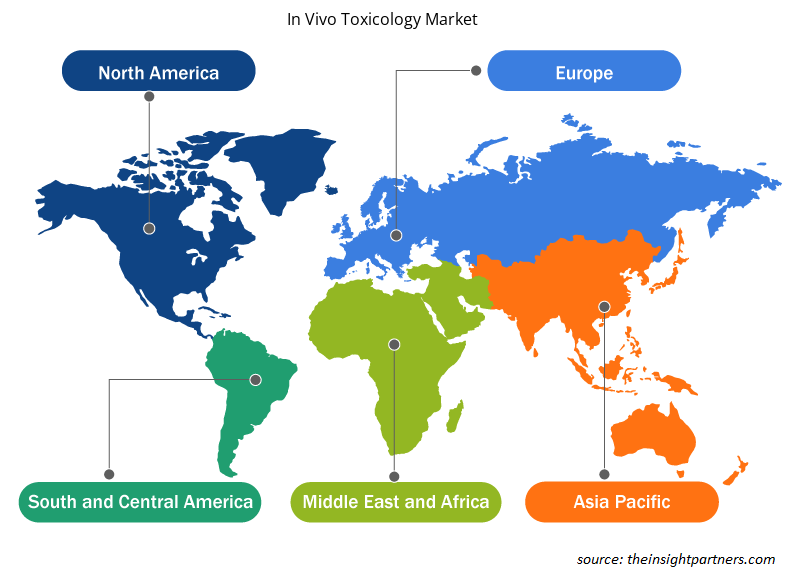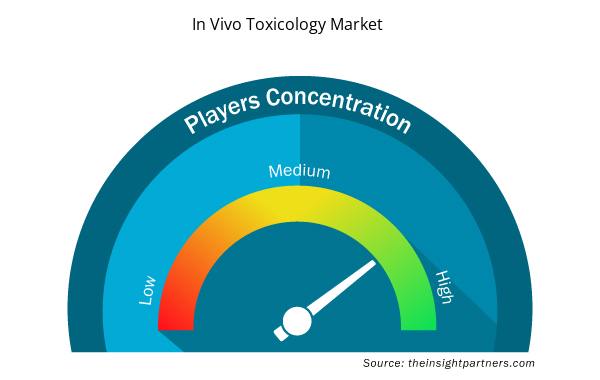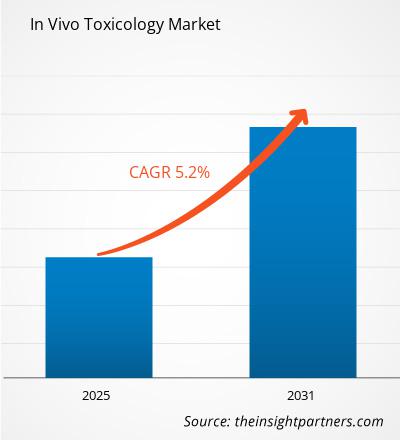The In Vivo Toxicology Market is expected to register a CAGR of 5.2% from 2025 to 2031, with a market size expanding from US$ XX Million in 2024 to US$ XX Million by 2031.
The research report on the in vivo toxicology market is segmented by product type into instruments, reagents, and software. Applications analyzed include systemic toxicity, organ-specific toxicity, and others. End-users covered in the study are pharmaceutical companies, academic and research institutes, and contract research organizations (CROs). Regional analysis covers North America, Europe, Asia Pacific, the Middle East and Africa, and South America. The market evaluation is provided in US$ for all segmental analyses.
Purpose of the Report
The report In Vivo Toxicology Market by The Insight Partners aims to describe the present landscape and future growth, top driving factors, challenges, and opportunities. This will provide insights to various business stakeholders, such as:
- Technology Providers/Manufacturers: To understand the evolving market dynamics and know the potential growth opportunities, enabling them to make informed strategic decisions.
- Investors: To conduct a comprehensive trend analysis regarding the market growth rate, market financial projections, and opportunities that exist across the value chain.
- Regulatory bodies: To regulate policies and police activities in the market with the aim of minimizing abuse, preserving investor trust and confidence, and upholding the integrity and stability of the market.
In Vivo Toxicology Market Segmentation
Product
- Instruments
- Animal models
- Reagents and kits
Testing Type
- Chronic toxicity testing
- Sub-chronic toxicity testing
- Sub-acute toxicity testing
- Acute toxicity testing
Toxicity Endpoint
- Immunotoxicity
- Systemic toxicity
- Carcinogenicity
- Genotoxicity
- Developmental and reproductive toxicity
Customize This Report To Suit Your Requirement
You will get customization on any report - free of charge - including parts of this report, or country-level analysis, Excel Data pack, as well as avail great offers and discounts for start-ups & universities
In Vivo Toxicology Market: Strategic Insights

- Get Top Key Market Trends of this report.This FREE sample will include data analysis, ranging from market trends to estimates and forecasts.
In Vivo Toxicology Market Growth Drivers
- Rising investment in R&D sector: The high investment in the pharmaceutical R&D sector tightly relates the demand for in vivo toxicology. With new chemical entities (NCEs) constantly being discovered and developed, reliable and comprehensive safety data for every NCE are required by pharmaceutical companies before advancing to human clinical trials. According to the WHO, about 10,000 NCEs are tested annually but only about 250 of these enter clinical trials. Hence, effective safety testing is paramount. In vivo toxicology will play a vital role in pointing out potential toxicity risks as early as possible during the development stage, thus averting costly failures during late-stage clinical trials. Researchers will be able to observe the physiological effects and responses in living organisms of new compounds being developed, ensuring only the safest products move forward in the development chain, which is an important aspect both for patient safety and regulatory approval.
- Advances in Animal Models: The developments in animal models, specifically GMOs and disease-specific models, have greatly increased the validity of in vivo toxicology studies. These advanced models better represent human biology, thus bridging the gap between preclinical and clinical findings. For instance, genetically engineered mice, like the Knockout Mouse, are designed to lack specific genes. This allows researchers to study the effect of removing certain genetic components on the toxicity of substances. Indeed, GMOs are increasingly used to model human diseases, such as cancer or Alzheimer's disease, and to test potential drug responses, thus improving the predictability of in vivo studies. Such advances have been supported by substantial investments in biotechnology, with global spending on genetically modified organisms projected to exceed $10 billion by 2026, further enhancing the capabilities of toxicology research.
- Regulatory Requirements: There are stringent regulatory requirements of different regions, such as the U.S. Food and Drug Administration (FDA) and the European Medicines Agency (EMA), where drugs and chemicals have to be cleared by in vivo toxicology before being approved in the market. For example, the FDA requires that new drugs undergo preclinical testing, such as in vivo studies, to determine the toxicity of the new drugs on organs and tissues. More often than not, these are the determining factors when a drug goes to clinical trials or is allowed to be commercially marketed. The relevance of adhering strictly to these regulatory procedures is unimaginable, as products made with nonconforming safety standards are always rejected or subjected to severe delay. As such, in vivo toxicology testing remains an integral part of a product's regulatory approval process, guarding the safety of products to consumers.
In Vivo Toxicology Market Future Trends
- Integration of Bioanalytical Methods: The integration of bioanalytical techniques in in vivo toxicology has changed the way toxic effects are studied. Techniques such as mass spectrometry, chromatography, and bioimaging are increasingly being used to track and quantify substances within the body. For instance, mass spectrometry can be used to measure the concentration of drugs and their metabolites in biological tissues, giving a clearer picture of their potential harmful effects. These advances have enabled researchers to detect toxicity at even lower doses. This helps enhance the precision and speed of safety assessments. The application of bioanalytical techniques also plays a key role in tracing long-term exposure to substances by major organs, an impossible task for traditional methods alone. Increased adoption of these techniques in toxicology testing ensures that drugs and chemicals are not only safe for short-term use but also for prolonged exposure, which is a growing concern in chronic disease treatments and environmental safety.
- Personalized Medicine: With the increasing shift towards personalized medicine, in vivo toxicology studies are evolving to account for genetic variability among individuals. The vision of personalized medicine is the tailoring of treatments to an individual's specific genetic makeup, enhancing efficacy and reducing adverse effects. Part of this paradigm shift involves applying genetic profiling in in vivo toxicology tests that predict how such a drug will potentially interact with specific genetic variants in a particular patient. In oncology, targeted therapies have been constructed to interact with the specific mutations found in cancer cells. Studies have demonstrated that up to 30% of cancer patients suffer from adverse drug reactions because of genetic variations in drug-metabolizing enzymes. In vivo toxicology can now be integrated with personalized approaches, thus better predicting individual responses to drugs and eventually reducing the risk of harmful side effects while improving treatment outcomes.
- Ethical Considerations and Alternative Methods: Ethical concerns over animal testing have sparked interest in alternative testing methods, which is a significant trend in in vivo toxicology. Although animal models are still the most widely used, there is a growing push to reduce reliance on them due to ethical concerns related to animal welfare. Other alternative testing methods, such as in vitro assays and organ-on-a-chip technology, which can mimic the in vivo condition without the use of animals, are under development. The European Union's regulation, namely the REACH (Registration, Evaluation, Authorization, and Restriction of Chemicals), has given specific targets to be achieved for animal testing, and companies are increasingly going for innovative alternatives. Despite this, in vivo studies are still considered indispensable for some endpoints of toxicity, such as long-term carcinogenicity studies, that cannot be replicated with in vitro methods. Hence, there is a trend towards a hybrid approach where in vivo tests are complemented by in vitro and computational models to reduce animal usage without compromising scientific rigor.
In Vivo Toxicology Market Opportunities
- Development of Humanized Animal Models: The humanized animal models are seen to promise much for the in vivo toxicology markets. They are genetically modified to express human genes, tissues, or immune systems thus mimicking more closely the human biology. The data obtained by using humanized models would better predict human responses, particularly in drug metabolism, immune response, and disease progression. For example, humanized mouse models are applied to study the results of new anti-cancer therapy approaches, providing a more dependable platform in which drug efficacy and safety can be tested. The global trend toward more personalized and human-relevant testing methods has been expected to drive the adoption of humanized models in toxicology, offering an opportunity for companies to innovate in the space and meet the growing demand for more predictive, humane, and accurate safety testing methods.
- Progress toward Predictive Toxicology: With time, in vivo studies incorporate predictive toxicology, which rapidly advances the discovery of drugs regarding their safety as well as its efficiency. Now, companies integrating computationally modeled simulations with artificial intelligence and machine learning in toxicological investigations allow drug development to detect toxic effects considerably earlier in its development process than was previously done. The research uses advanced technologies, such as the analysis of big data from in vivo experiments. These technologies utilize algorithms to predict the effect of drug compounds on different organs or tissues. AI models, for instance, are being developed to predict the cardiotoxicity of new drugs to reduce the number of time-consuming and costly animal trials. As the ability to predict toxicity more accurately improves, there will be increased reliance on predictive models in toxicology, potentially reducing the overall need for traditional in vivo studies. This presents a substantial opportunity for innovation, as companies develop and refine predictive tools to enhance drug safety and streamline the drug development process.
- Regulatory Incentives for Alternative Testing Methods: The regulatory bodies are also increasingly giving incentives to the development of alternative testing methods that avoid or replace animal testing. For instance, under the U.S. FDA's 21st Century Cures Act, the development of innovative technologies, including alternative testing methods, is encouraged to assess the safety of drugs and chemicals. The agencies embrace the use of in silico models, 3D tissue cultures, and organ-on-chip platforms as part of the regulatory landscape. This is not limited to concerns over ethical considerations but also to the accelerated pace of testing and cost savings relating to animal trials. Companies that can capitalize on these regulatory shifts include companies that can invest in alternative methods to obtain faster market approval pathways and address growing public and institutional pressure to reduce animal testing.
In Vivo Toxicology Market Regional Insights
The regional trends and factors influencing the In Vivo Toxicology Market throughout the forecast period have been thoroughly explained by the analysts at Insight Partners. This section also discusses In Vivo Toxicology Market segments and geography across North America, Europe, Asia Pacific, Middle East and Africa, and South and Central America.

- Get the Regional Specific Data for In Vivo Toxicology Market
In Vivo Toxicology Market Report Scope
| Report Attribute | Details |
|---|---|
| Market size in 2024 | US$ XX Million |
| Market Size by 2031 | US$ XX Million |
| Global CAGR (2025 - 2031) | 5.2% |
| Historical Data | 2021-2023 |
| Forecast period | 2025-2031 |
| Segments Covered |
By Product
|
| Regions and Countries Covered | North America
|
| Market leaders and key company profiles |
In Vivo Toxicology Market Players Density: Understanding Its Impact on Business Dynamics
The In Vivo Toxicology Market market is growing rapidly, driven by increasing end-user demand due to factors such as evolving consumer preferences, technological advancements, and greater awareness of the product's benefits. As demand rises, businesses are expanding their offerings, innovating to meet consumer needs, and capitalizing on emerging trends, which further fuels market growth.
Market players density refers to the distribution of firms or companies operating within a particular market or industry. It indicates how many competitors (market players) are present in a given market space relative to its size or total market value.
Major Companies operating in the In Vivo Toxicology Market are:
- Thermo Fisher Scientific
- Danaher
- Charles River Laboratories
- Labcorp
- The Jackson Laboratory
- Data Sciences International
Disclaimer: The companies listed above are not ranked in any particular order.

- Get the In Vivo Toxicology Market top key players overview
Key Selling Points
- Comprehensive Coverage: The report comprehensively covers the analysis of products, services, types, and end users of the In Vivo Toxicology Market, providing a holistic landscape.
- Expert Analysis: The report is compiled based on the in-depth understanding of industry experts and analysts.
- Up-to-date Information: The report assures business relevance due to its coverage of recent information and data trends.
- Customization Options: This report can be customized to cater to specific client requirements and suit the business strategies aptly.
The research report on the In Vivo Toxicology Market can, therefore, help spearhead the trail of decoding and understanding the industry scenario and growth prospects. Although there can be a few valid concerns, the overall benefits of this report tend to outweigh the disadvantages.
- Historical Analysis (2 Years), Base Year, Forecast (7 Years) with CAGR
- PEST and SWOT Analysis
- Market Size Value / Volume - Global, Regional, Country
- Industry and Competitive Landscape
- Excel Dataset



Report Coverage
Revenue forecast, Company Analysis, Industry landscape, Growth factors, and Trends

Segment Covered
This text is related
to segments covered.

Regional Scope
North America, Europe, Asia Pacific, Middle East & Africa, South & Central America

Country Scope
This text is related
to country scope.
Frequently Asked Questions
The In Vivo Toxicology Market is expected to register a CAGR of 5.2% from 2025-2031.
The major driving factors supporting the In Vivo Toxicology market growth are - Rising investment in R&D sector, Advances in animal models, Regulatory requirements
Key future trends in the In Vivo Toxicology Market are -Integration of bioanalytical methods, Personalized medicine, Ethical considerations and alternative methods
Key companies in the In Vivo Toxicology Market are- Thermo Fisher Scientific, Danaher, Charles River Laboratories, Labcorp, The Jackson Laboratory, Data Sciences International, Envigo, Eurofins Scientific, Perkinelmer, SRI International
The report can be delivered in PDF/PPT format; we can also share excel dataset based on the request.
Some of the customization options available based on request are additional 3–5 company profiles and country-specific analysis of 3–5 countries of your choice. Customizations are to be requested/discussed before making final order confirmation, as our team would review the same and check the feasibility.
Trends and growth analysis reports related to Life Sciences : READ MORE..
1. Thermo Fisher Scientific
2. Danaher
3. Charles River Laboratories
4. Labcorp
5. The Jackson Laboratory
6. Data Sciences International
7. Envigo
8. Eurofins Scientific
9. Perkinelmer
10. SRI International

 Get Free Sample For
Get Free Sample For